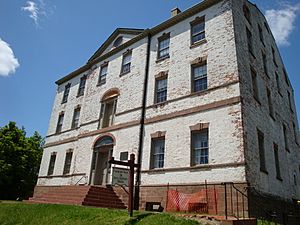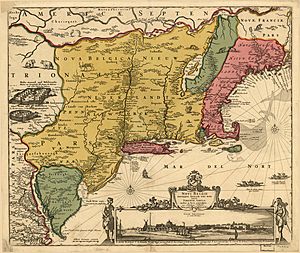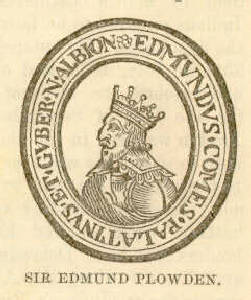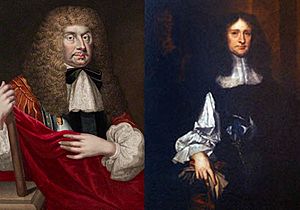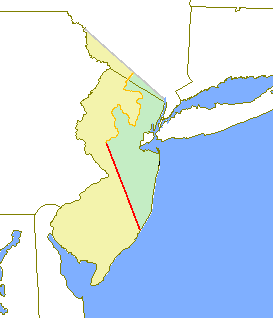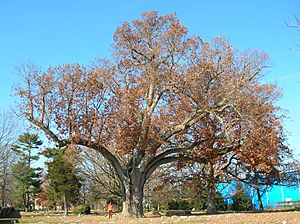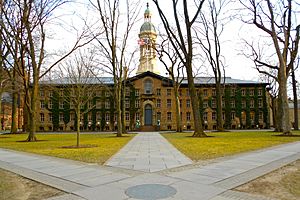List of colonial governors of New Jersey facts for kids
The land that became New Jersey was first settled by Dutch and Swedish people in the early 1600s. In 1664, England took control of this area, which was then called New Netherland. This territory included parts of what are now New York, New Jersey, and Delaware. New Jersey remained an English possession until the American colonies declared independence in 1776.
In 1664, James, Duke of York (who later became King James II), gave a part of New Jersey to Sir George Carteret and John Berkeley. They had supported the king during the English Civil War. Carteret and Berkeley later sold their shares to other owners, creating two separate areas: East Jersey and West Jersey. The exact border between these two parts was often debated. They were distinct political areas from 1674 to 1702.
West Jersey was mostly a Quaker colony. This was because of the influence of William Penn, who founded Pennsylvania, and other important Quaker investors. Many early settlers came from England, Scotland, and Ireland to escape religious unfairness. East Jersey had less Quaker influence. Many of its early settlers came from other colonies like New England, Long Island, and the West Indies. Towns like Elizabethtown and Newark had a strong Puritan influence.
In 1702, Queen Anne reunited both parts of New Jersey into one royal colony. A royal governor was appointed by the Queen. Until 1738, New Jersey shared its royal governor with New York. New Jersey was governed by appointed governors until 1776. William Franklin was the last royal governor before the American Revolution. In June 1776, the Provincial Congress of New Jersey removed Franklin from his position and arrested him. They then adopted a state constitution and made New Jersey an independent state. The new constitution allowed all wealthy inhabitants, including single women and Black people, to vote until 1807. William Livingston became New Jersey's first elected governor on August 31, 1776. New Jersey was one of the original Thirteen Colonies. It was the third colony to approve the United States Constitution on December 18, 1787. On November 20, 1789, New Jersey was the first state to approve the Bill of Rights.
Contents
New Jersey's Early Leaders
Dutch Rule: New Netherland (1624–1664)
New Netherland was a Dutch colony in the 1600s. It covered areas along the eastern coast of North America. These areas are now parts of New York, New Jersey, Delaware, Connecticut, Pennsylvania, and Rhode Island. The main city was New Amsterdam, located where New York City is today.
New Netherland started as a business to trade furs in North America. By the 1650s, the colony grew a lot and became an important trading port. The leader of the Dutch colony was called the Director or Director-General. On August 27, 1664, English ships led by Richard Nicolls sailed into New Amsterdam's harbor. They demanded that New Netherland surrender. This event started the Second Anglo-Dutch War. The Treaty of Breda later officially gave the territory to England.
| Portrait | Director or Director-General |
Took office | Left office | Notes |
|---|---|---|---|---|
| — | Cornelius Jacobsen May | 1624 | 1625 |
|
| — | Willem Verhulst | 1625 | 1626 |
|
 |
Peter Minuit | 1626 | 1631 |
|
| — | Sebastiaen Jansen Krol | 1632 | 1633 | — |
 |
Wouter van Twiller | 1633 | 1638 |
|
| — | Willem Kieft | 1638 | 1647 |
|
 |
Peter Stuyvesant | 1647 | 1664 |
|
Swedish Colony: New Sweden (1638–1655)
New Sweden was a Swedish colony along the Delaware River from 1638 to 1655. It included land in present-day Delaware, New Jersey, and Pennsylvania. After being removed as director of New Netherland, Peter Minuit helped create the first Swedish colony. The Swedes wanted to grow their influence by farming tobacco and trading furs.
The New Sweden Company was formed with investors from Sweden, Finland, the Netherlands, and Germany. Minuit arrived in 1638. Willem Kieft, the Dutch Director of New Netherland, did not like the Swedish presence. But Minuit ignored him because he knew the Dutch could not fight them. The colony built Fort Nya Elfsborg near present-day Salem, New Jersey, in 1643.
In May 1654, Swedish soldiers captured Fort Casimir, a Dutch fort. In response, the Dutch Director-General Peter Stuyvesant sent an army to the Delaware River. This forced the Swedish forts and settlements to surrender in 1655. The Swedish settlers kept some local control, their religion, and lands. However, this ended when the English took over the New Netherland colony in 1664.
The New Albion Colony (1634–1649)
In 1634, King Charles I of England gave a special paper to Sir Edmund Plowden. This paper allowed him to start a colony in North America. This colony, called New Albion, was planned to cover parts of what are now New Jersey, New York, Delaware, and Maryland.
Captain Thomas Young explored the Delaware River valley in the 1630s. Plowden spent several years gathering money and people for the colony. In 1642, Plowden sailed from England to settle the colony. This attempt failed due to a mutiny. For the next seven years, Plowden stayed in Virginia, managing the colony's plans and selling land rights.
Plowden returned to England in 1649 to get more money. He promoted the colony as a safe place for Roman Catholics who were forced out during the English Civil War. Plowden tried to return to his colony but was held in prison for debts. He died poor in 1659. A map from 1651 mentions Plowden's plan for New Albion. It also notes that the Swedes had settled there and were trading furs.
English Proprietary Colony (1664–1702)
Governors under the Lords Proprietor (1664–1673)
In 1664, the Dutch surrendered New Netherland to the English. James, Duke of York, put Richard Nicolls in charge as Deputy-Governor. Nicolls first promised the Dutch colonists that they could keep their property and practice their religion freely. He also introduced English laws. Nicolls was governor until 1668. However, the Duke of York gave part of New Netherland (present-day New Jersey) to Sir George Carteret and John Berkeley. This was a reward for their loyalty during the English Civil War.
This new territory was named the Province of New Caesaria, or New Jersey. It was named after the island of Jersey, an English Channel island that was a stronghold for the king's supporters. Carteret and Berkeley became the two English Lords Proprietor of New Jersey. In 1665, they created the "Concession and Agreement." This document explained how power would be shared in the province. It also offered religious freedom to all settlers. The Lords Proprietor chose Philip Carteret, Sir George's brother, as the first governor.
| Portrait | Governor | Took office | Left office | Notes |
|---|---|---|---|---|
| — | Richard Nicolls | 1664 | 1665 |
|
| — | Philip Carteret | 1665 | 1672 |
|
| — | John Berry | 1672 | 1673 |
|
Dutch Retake New Netherland (1673–1674)
In 1673, during the Third Anglo-Dutch War, the Dutch recaptured New Amsterdam. They renamed it "New Orange." Admiral Cornelis Evertsen and Captain Anthony Colve led this effort. Evertsen returned to the Netherlands in July 1674. He was accused of not following orders. He was supposed to conquer other British colonies, not retake New Amsterdam. In 1674, the Dutch had to give New Amsterdam back to the British. This was part of the Second Treaty of Westminster.
| Portrait | Governor | Took office | Left office | Notes |
|---|---|---|---|---|
| — | Anthony Colve | 1673 | 1674 |
|
East and West Jerseys (1674–1702)
After the British regained New Jersey and New York, New Jersey became a proprietary colony again. It was divided into East Jersey and West Jersey. In 1674, Berkeley sold his share of West Jersey to Edward Byllynge and John Fenwick. Fenwick quickly went to the colony to start a settlement called Fenwick's Colony, which became Salem. Byllynge had money problems, so he sought help from William Penn and others.
The land issues were settled in 1676 with the Quintipartite Deed. This agreement divided the colony into East and West Jersey. West Jersey was mainly a Quaker project. It focused on settling the lower Delaware River area. It was linked to William Penn and other important people who helped colonize Pennsylvania. After Carteret died, his family sold his share of East Jersey to twelve investors. Most of them were Quakers. They asked Robert Barclay, a Quaker leader, to be governor. East Jersey's growth was mainly connected to New England and New York.
This setup lasted for about thirty years. But because of problems with how the colonies were run, the owners of both colonies gave their governing rights to Queen Anne. On April 17, 1702, New Jersey became a crown colony. The original owners kept their land rights. The East Jersey owners dissolved their company in 1998. The West Jersey Proprietors still exist today in Burlington, New Jersey.
For a short time starting in 1688, New York, East Jersey, and West Jersey were part of the Dominion of New England. Francis Nicholson, a Lieutenant Governor, oversaw New York and New Jersey. The owners of East Jersey were angry that their charters were taken away. They asked Edmund Andros, the governor of the dominion, for special land rights. The colony was too big for one governor, and Andros was very unpopular.
News of the Glorious Revolution in England reached Boston in 1689. People in New England and New York revolted against Andros. They feared he wanted to force Catholic rule on the colony. Leisler's Rebellion in New York City removed Nicholson. After these events, the colonies returned to their old forms of government until 1702.
Governors of East Jersey (1674–1702)
| Portrait | Governor | Took office | Left office | Notes |
|---|---|---|---|---|
| — | Philip Carteret | 1674 | 1682 |
|
 |
Edmund Andros | 1674 | 1681 |
|
| — | Robert Barclay | 1682 | 1688 |
|
 |
Edmund Andros | 1688 | 1689 |
|
| — | Vacant | 1690 | 1692 |
|
| — | Andrew Hamilton | 1692 | 1697 |
|
| — | Jeremiah Basse | 1698 | 1699 |
|
| — | Andrew Hamilton | 1699 | 1702 |
|
Governors of West Jersey (1680–1702)
| Portrait | Governor | Took office | Left office | Notes |
|---|---|---|---|---|
| — | Edward Byllynge | 1680 | 1687 |
|
| — | Dr. Daniel Coxe | 1687 | 1688 |
|
 |
Edmund Andros | 1688 | 1689 |
|
| — | Dr. Daniel Coxe | 1689 | 1692 |
|
| — | Andrew Hamilton | 1692 | 1697 |
|
| — | Jeremiah Basse | 1698 | 1699 |
|
| — | Andrew Bowne | 1699 | 1699 |
|
| — | Andrew Hamilton | 1699 | 1702 |
|
British Crown Colony (1702–1776)
Governors of New York and New Jersey (1702–1738)
Soon after becoming queen, Queen Anne (1665–1714) reunited East Jersey and West Jersey. She made them a royal colony. She appointed her cousin, Edward Hyde, Viscount Cornbury, as the first Royal Governor. In 1702, the two proprietary colonies gave their power to the Crown. New Jersey became a crown colony with a governor and a twelve-member council chosen by the British monarch. It also had a twenty-four-member assembly. Its members were elected by colonists who owned at least 1,000 acres of land.
For the next forty years, New Jersey and New York shared one royal governor. The Crown's representatives were often not very good at their jobs. The royal governor often ignored New Jersey's matters. Because of this, the colonists had a lot of freedom. The original owners still had power because they controlled land titles and sales. The relationship between many Royal Governors and the assembly was often difficult. The assembly would sometimes refuse to pay the governor's salary if they disagreed with laws. Historians say that the government had different groups. These groups often changed who they supported.
During this time, the colony's population grew a lot. It went from 14,000 people in 1700 to almost 52,000 by 1740. It was a diverse colony. Queen Anne and Royal Governor Hunter brought German families to New York's Hudson Valley. Many of these German families later settled in New Jersey. West Jersey had Irish, English, Welsh, and Scottish Quakers. It also had descendants of Swedish and Finnish colonists. Dutch and Huguenot families from New York settled in the Raritan River and Hackensack River valleys. New Englanders from Connecticut and Long Island, and English planters from Barbados, arrived with African slaves. The colony allowed religious freedom. This meant there were many different churches, including Dutch Reformed, Lutheran, Huguenot, Quaker, Puritan, Congregationalist, Presbyterian, Baptist, and Anglican churches.
| Portrait | Governor | Took office | Left office | Notes |
|---|---|---|---|---|
 |
Edward Hyde, Lord Cornbury | 1701 | 1708 |
|
| — | John Lovelace, 4th Baron Lovelace | 1708 | 1709 |
|
| — | Richard Ingoldesby | 1709 | 1710 |
|
 |
Robert Hunter | 1710 | 1720 |
|
 |
William Burnet | 1720 | 1728 |
|
| — | Colonel John Montgomerie | 1728 | 1731 |
|
 |
Lewis Morris | 1731 | 1732 |
|
 |
Sir William Cosby | 1732 | 1736 |
|
| — | John Anderson | 1736 | 1736 |
|
| — | John Hamilton | 1736 | 1738 |
|
| — | John West, 1st Earl De La Warr | 1737 | 1737 |
|
Governors of New Jersey (1738–1776)
After problems with land purchases in 1737, relations between colonists and Native American tribes became difficult. During these years, colonists moved from coastal cities to the colony's wild northwestern areas. The government often organized these wilderness areas into townships. Many were named after English and colonial political figures. By the 1750s, violent attacks against these settlers and fears of French support led to the French and Indian War.
During this time, the colonial government offered money to colonists who killed Native Americans. They also built forts in the Minisink region (the upper Delaware River valley). Military units were formed to defend this area and attack Native American villages. The fighting began to calm down with the Treaty of Easton in October 1758. This treaty was negotiated by New Jersey Royal Governor Francis Bernard, Pennsylvania Attorney-General Benjamin Chew, and chiefs of 13 Native American nations.
New Jersey was the only province to have two colleges started during the colonial period. The colony's governors helped establish them. Governors John Hamilton, John Reading, and Jonathan Belcher helped start The College of New Jersey (now Princeton University). It was founded in 1746 in Elizabethtown by a group of "New Lighters." In 1756, the school moved to Princeton. In 1766, Governor William Franklin issued the charters to establish Queens College (now Rutgers University) in New Brunswick. Its purpose was to "educate the youth in language, liberal, the divinity, and useful arts and sciences." It also trained future ministers for the Dutch Reformed Church. Franklin issued a second charter in 1770 after the college's trustees asked for changes.
In the last year of William Franklin's time as governor, his power decreased. He was ignored by the rebellious colonists. The province was effectively run by the Provincial Congress of New Jersey (1775–76). Colonial militia put Franklin under house arrest in January 1776. He was formally removed from office in June 1776 when the Provincial Congress imprisoned him. Franklin called the Provincial Congress an "illegal assembly." Under its president, Samuel Tucker, the Provincial Congress adopted a state constitution. It then reorganized the province into an independent state. William Livingston was elected as New Jersey's first governor on August 31, 1776.
| Portrait | Governor | Took office | Left office | Notes |
|---|---|---|---|---|
 |
Lewis Morris | 1738 | 1746 |
|
| — | John Hamilton | 1746 | 1747 |
|
| — | John Reading | 1747 | 1747 |
|
 |
Jonathan Belcher | 1747 | 1757 |
|
| — | John Reading | 1757 | 1758 |
|
 |
Francis Bernard | 1758 | 1760 |
|
| — | Thomas Boone | 1760 | 1761 |
|
| — | Josiah Hardy | 1761 | 1763 |
|
 |
William Franklin | 1763 | 1776 |
|


